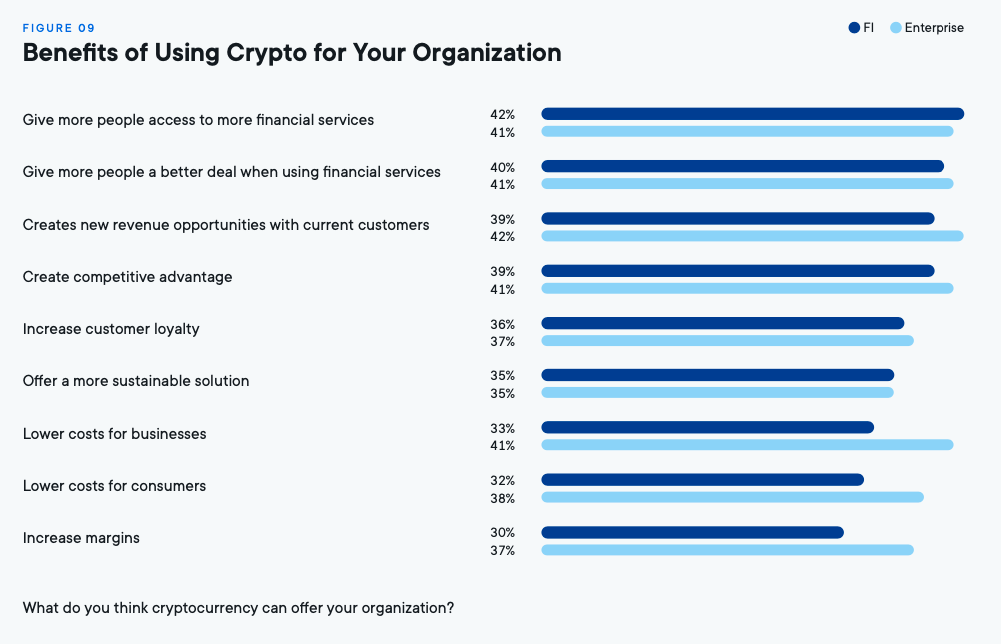More and more mature technologies
According to a survey conducted by Ripple, blockchain technology and cryptocurrencies are gradually maturing. This can be seen in companies, where they are increasingly used, but also with consumers, who are more and more likely to understand and own cryptocurrencies and non-fungible tokens (NFTs).
The explosion of NFTs
This surely did not escape you… LNFTs have been experiencing a galloping democratization since last year. Ripple thus notes an increase in the trading volume of non-fungible tokens of 38,000% between 2020 and 2021. And in the third quarter of 2021 alone, more than 10 billion dollars of NFTs were traded.
This trend is not about to run out of steam, as this new tool allows celebrities and brands alike to engage their communities in innovative, fun and effective ways. NFTs are also riding the growing popularity of metaverses, in which they introduce the notion of ownership.
Ripple’s report particularly looks at the reasons why the general public is turning to NFTs, emphasizing that the main motivation is their functions, not the emotional aspect that surrounds them.
Why do people buy NFTs? – Source: Ripple
The company also asked surveyed consumers what themes seemed to them the mostinteresting uses in terms of the use of NFTs. And surprisingly, music comes out on top, ahead of “collectibles” and video games.

What types of NFTs are consumers most interested in? – Source: Ripple
Ripple also evokes barriers to mass adoption of NFTsespecially their complexity which constitutes the main obstacle to their democratization. The company also points the finger at their excessively high prices, which discourage many people. But Ripple qualifies these difficulties, emphasizing that they should be overcome quickly.
? To learn more about crypto trends in 2022: “Layer 1” wars, regulation, new uses of NFTs… Coinbase predicts the year 2022
The obstacle of the durability of NFTs
The company also mentions the problem of NFT durability. She thus takes the example of the mint of an NFT on the Ethereum blockchain, which consumes as much energy as an American household for a week. Of course, Ripple takes the opportunity to highlight its in-house solution, the XRP Ledger, which shines in particular with its carbon neutrality, but also the Flow and Solana blockchains, which are much less greedy than Ethereum.
If the question of the durability of NFTs is not currently at the heart of concerns, this could quickly change. Indeed, Ripple has surveyed consumers and developers to find out their position on the matter. And the conclusion is without appeal. 3 in 4 consumers prefer durable NFTs, while 20% say they would never buy anything else. As for developers, 66% believe that the organization they work for is more likely to opt for a sustainable blockchain, and that is what their customers want.
The report looks more broadly at consumer attitudes towards the sustainability of cryptos in general. And again, we observe that 75% would rather buy a sustainable cryptocurrency, while one in five consumers say they would never want to buy anything else.

What is the attitude of consumers towards the sustainability of cryptocurrencies? – Source: Ripple
? To go further on the subject of sustainability: Banks pollute much more than Bitcoin (BTC), according to a study
Central Bank Digital Currencies (MNBCs) Set to Hit the World
According to Ripple’s report, if only a few countries have already launched their digital currency, 80% of central banks worldwide are currently exploring the use of so-called MNBCs. As a reminder, these are neither more nor less than tokens from a blockchain aimed at transforming fiduciary currencies (dollar, euro, yuan, etc.) into digital assets.
Whether financial institutions or not, an overwhelming majority of companies believe that MNBCs will have a significant impact in the years to come. Ripple asked them about the benefits they expect from the introduction of this technology, and thenancial institutions ranked improving national competitiveness in the global economy first, just ahead of payment system efficiency. The other types of companies, for their part, put the efficiency of the payment system in first place, ahead of the strengthening of monetary policy.
? To understand everything about MNBC: Digital Central Bank Currencies (MNBC) – What are they and how do they work?
The use of cryptos by financial institutions and companies
According to the survey conducted by Ripple, 76% of financial institutions plan to use crypto in the next three years. A figure that rises to 71% for other types of businesses. And contrary to popular belief, they are not motivated solely by their speculative aspect. The number one reason given for holding cryptocurrencies is for payment purposes. They also emphasize their interest in managing their portfolios, especially as a hedge against inflation and other types of assets.
Even more than for MNBCs, the vast majority of companies and financial institutions surveyed believe that cryptocurrencies will have a significant impact in the near future. The report details the benefits these companies hope to see with mass crypto adoption. In the top two places are improving inclusiveness and fairness for consumers. This translates into broader access to financial services, and on terms that are more to the benefit of their customers.

What can the use of cryptocurrencies bring to companies? – Source: Ripple
In view of these responses, one wonders what prevents companies such as financial institutions from adopting cryptocurrencies on a massive scale. Like always, fraud and scams top the list of barriers to their democratization, ahead of the vagueness of regulations and price volatility. However, the banks would have every interest in getting started. Indeed, 65% of consumers surveyed say they are interested in buying cryptocurrencies directly from them. A figure that rises to 81% among the most experienced users.
If you want to know the latest assessment of the French crypto ecosystem, we encourage you to read our summary of the findings of the Adan / KPMG France study. In this survey which has just been published, we learn in particular that 8% of French people have already acquired cryptocurrencies, and that 30% plan to take the plunge. The revolution is on !
Newsletter ?
Get a crypto news recap every Sunday ? And that’s it.

